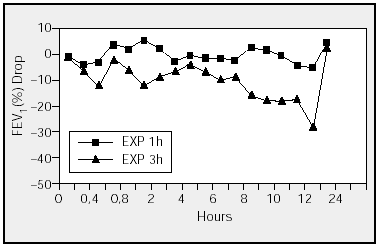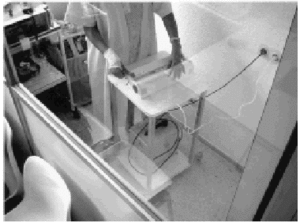Introduction
Occupational asthma is a disease characterized by variable obstruction of the airway and/or bronchial hyperresponse owing to causes and conditions attributable to a particular work environment1. Depending on whether or not a latency period occurs between exposure to the agent and the onset of symptoms, two types of occupational asthma have been described: immunologic and nonimmunologic. Nonimmunologic occupational asthma is the reaction observed in patients whose illness is caused by irritants. This type of asthma, in which there is no latency period, can occur after a single exposure to a high concentration of a particular irritant2,3. Immunologic occupational asthma is characterized by the fact that onset of symptoms occurs only after a latency period. It may be mediated by an IgE-dependent immunologic mechanism or by other mechanisms not dependent on IgE, some of which are as yet not well understood4.
It is believed that between 5 and 15% of all asthma cases that develop in adulthood are work related5, and asthma is currently considered to be the most common work-related respiratory pathology in industrialized countries6 with more than 250 different agents involved in its genesis7,8. The majority of these agents have been studied in depth, but in certain cases there is still some doubt regarding the etiological agent involved and the possible mechanism of action. Such is the case of food packer's asthma, initially known as meat wrapper's asthma. While polyvinyl chloride (PVC) has been implicated as the causal agent in this type of asthma9,10, there remains some doubt as to whether the illness is caused directly by this agent or, alternatively, by the products of its thermal degradation. Doubt also exists as to whether this type of asthma is immunologic, affecting only sensitized individuals, or whether it is a nonimmunologic type of asthma caused by the irritant effect of the products of combustion on the bronchial mucosa.
The objective of this case report is to present the first recorded case of food packer's asthma in Spain and to discuss, on the basis of the results of the challenge test performed, the possible origin of this disease.
Clinical findings
The patient was a 26-year-old woman, a cigarette smoker of 5 packets/year with no other toxic habits or relevant medical history, who had been working for four years for a company involved in the manufacture and sale of a range of fish products. Six months after transferring from her usual job in a cleaning room to a new post in the vacuum packing area, the woman started to experience delayed symptoms, such as cough, bronchospasm and dyspnea, at the end of the working day and during the night. On two occasions she had to go to an emergency room. The patient's symptoms improved with inhaled beta-adrenergic drugs, and were clearly work related since they improved on weekends and during vacations and other times she was away from the workplace.
A chest x-ray was normal. Test results revealed an eosinophil percentage of 8.5 % and a total serum IgE level of 90 kU/l. Skin tests for common respiratory allergens were negative. A study of lung function revealed an obstructive ventilatory pattern with a forced vital capacity (FVC) of 3.78 l (104%), a forced expiratory volume in one second (FEV1) of 2.38 l (75%) and FEV1% of 63%, with a positive bronchodilator test showing an improvement in FEV1 of 16%. A methacholine challenge gave a positive result, with a PCO2 of 0.3 mg/ml. A record of peak expiratory flow rate measured by the patient during two working weeks and one week away from the workplace revealed a variation on working days of more than 20%; and visual interpretation of the record was consistent with the diagnosis of occupational asthma. In the hospital, a specific challenge test was carried out in which the patient's working conditions were simulated in a provocation chamber (Fig. 1) 13. No response was observed after the initial 1-hour exposure on the first day. On the second day, after a 3-hour exposure, the patient experienced a delayed positive response (Fig. 2), with a drop in FEV1 of 28% approximately 12 hours after exposure, and bronchospasm which required treatment with inhaled bronchodilators. In order to rule out a possible irritant effect, the same specific challenge test was carried out on two volunteer asthmatic patients whose bronchial hyperresponse to methacholine was similar to that observed in the patient. The result was negative in both cases.
Fig. 1. Provocation chamber and shrink wrapping machine used in the specific challenge test.
Fig. 2. Results of the specific challenge test. FEV1: forced expiratory volume in one second.
When the patient was transferred away from the packing area and relocated in her original job, the symptoms disappeared and have not reappeared to date.
Discussion
PVC, a thermoplastic material, is a product of a chemical combination of carbon, hydrogen and chlorine. The raw materials are derived from oil and common salt. Spain has approximately 1750 PVC converter companies, which provide employment for some 38 000 people directly and over 150 000 indirectly. It is estimated that the PVC industry provides employment for more than 542 000 people in Europe14.
Most industrial processes using PVC involve heating the product in order to take advantage of its physical properties. This heating process can give rise to the release of PVC in gaseous form and of irritative products such as hydrochloric acid and carbon monoxide. Exposure to these agents can cause acute intoxication in the central nervous system and irritative lesions in airway and other mucosal tissues. These effects are directly related to the length of exposure and the quantity of toxic agent released12.
In 1973, Sokol et al15 described the first recorded cases of occupational asthma attributed to PVC inhalation in 3 patients whose job was vacuum packing meat products. Subsequent studies carried out in the few recorded cases of this type of asthma have cast doubt on the etiological role of PVC. Andrasch et al10, after carrying out various challenge tests, attributed the etiology of the process to an additional source of sensitizing agents released as a result of the thermal activation of substances used in labeling the packaged food. These results are, however, difficult to evaluate since the challenge tests carried out did not simulate the usual workplace exposure, and may well represent an overexposure that could have resulted in a bronchoconstrictor response caused by direct irritation. Other causal agents that have been associated with this type of asthma are polyethylene16, anhydride acids and/or soy oil derivatives11, also released during the heating process. Finally, some authors believe this to be a nonimmunologic, irritative asthma caused by inhalation of the combustion products of PVC12.
This case is interesting for two reasons: firstly because it is the first recorded occurrence of this type of asthma in Spain; and secondly because of the results observed in the challenge test. The fact that the patient's response was delayed in both clinical and functional terms, and that this response was not observed in the control asthma patients suggests that this is in effect an immunologic rather than an irritative type of asthma. The clinical characteristics of the case -- delayed onset of symptoms after exposure, the absence of elevated IgE, and the delayed response to the challenge test -- lead us to conclude that the immunological mechanism involved was not IgE dependent.
In this case, in which the work involved shrink wrapping fish in sheets of plastic, it was not possible to establish the specific causal agent, although any of the substances described above could have played a role. The recent demonstration that PVC in resinous form can cause occupational asthma even without being heated17 once again opens up the possibility that PVC could be the causal agent in this type of asthma. In view of the widespread use of PVC in our country, we believe that it is important to investigate its possible role in cases of asthma in order to facilitate the early diagnosis of patients who may possibly be affected, since early avoidance of the causal agent represents the best treatment in patients suffering from occupational asthma18.
Correspondence to: Dr. X. Muñoz.
Servicio de Neumología. Hospital General Vall d’Hebron.
Paseo Vall d’Hebron, 119. 08035 Barcelona. Spain.
Email: xmgall@hg.vhebron.es.
Manuscript received 2 December 2002.
Accepted for publication 30 December 2002.














